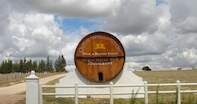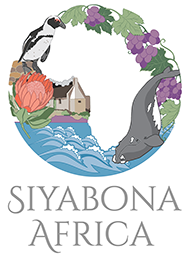
The Angels' Share
Brandy was discovered by accident, centuries ago, in the harbour town of La Rochelle, France. Barrels of distilled wine sat waiting to be exported but war came and the barrels were forgotten about for years.When they were finally rediscovered and opened, merchants were astonished to see the rough colourless firewater had matured into a rich golden liquid. And thus brandy was born. Today, the 300 litre barrels in which the brandy matures, are fashioned from the ancient oaks of the forests of France. The trees are only harvested when they are more than 100 yrs old. They are sawn into logs and the logs, in turn, are split into staves in such a way that the grain of the wood runs parallel, in order to ensure watertight barrels.The staves are left outside to dry for three to five years. Only then, can the cooper shape the wood into its final form. The time-honoured craft of barrel-making is depicted in rock art found in an Egyptian tomb, dating back to 2690 BC. At Van Ryn's, the rhythmic beat of the cooper's tools can be heard as he hammers the rings around the staves into barrel shape. Dry leaves from local bulrushes are inserted into the slits between staves to prevent leakage.The coopers work with the traditional hand-held instruments that have been used for centuries. It takes one cooper a day to make a new barrel. Brandy is distilled from white wine. The best grapes for brandy are low in sugar and high in natural fruit acids such as chenin blanc and colombar, which are grown in the drier wine areas of the Cape like the Breede River Valley, Worcester, Robertson and the Klein Karoo. The grapes are lightly pressed before the distilling process begins. The concept of distillation is to separate the alcohol from the water in the wine.Thus the wine is boiled, the water removed and the remaining alcohol more concentrated. The wine is distilled in traditional copper pot stills. The Cape is the only place outside Cognac in France where the government allows no other method of distillation. The brick and copper pot still at van Rijn's comes from the Cognac region of France and dates back to 1880. Copper is a non-poisonous metal and a good conductor of heat. A fire is made inside and the white wine is boiled. Vapour rises through the serpentine copper pipe, called the 'swan's neck,' and heats up the wine.To make one litre of brandy you need 5 litres of wine. The wine is bought in from the co-ops and needs to be distilled immediately to prevent oxidation. From the first distillation comes 300 litres of 'low wine' with a 30% alcohol content. This goes into storage as, with its high alcohol content, it is able to maintain its freshness until all the wine is in by mid April and ready for the second distillation.The second distillation yields the 'head', 'heart' and 'tail.' The first 1% distilled has an alcohol content of 83% and a very unpleasant nose. This 'head' is kept away from the brandy.The next 300 litres is the 'heart' with a 70% alcohol volume. With its clean concentrated fruit flavour, it is used for maturation in Limousin oak barrels. The remaining 30% alcohol content is the'tail.' The head and tail is sent back to the low wine reserves and redistilled.Brandy can be matured for up to 20 years. South African law requires at least 3 years of maturation. At van Ryn's, nothing is matured for less than 5 years. Their Viceroy label, popular for mixes, is aged for 5 years while the Van Ryn's label pronounces a 10 year old brandy. Even today, exactly what happens in the maturation process remains a mystery. While in the cellar, 3% of the barrels' contents evaporate each year.This is known as the angels' share in recognition of their contribution in transforming brandy during maturation. Even the tax man pays them their dues. Brandy cellars get an excise rebate on their evaporation losses. As content diminishes, the flavours become concentrated. In the century-old barrel cellar, you can smell the angels' share in air, although, frankly, it smells more like the breath of a wino.The finished product from pot still brandy has an alcohol content of 38%. Other South African brandies have a volume of 43%. They are blended with 30% coming from the pot still and the rest from the continous still.These brandies are lighter-bodied and good for mixes like that perennial South African favourite, brandy and Coke.A lesser known attraction than the many wine routes in the Cape region, is the Brandy Route which includes:
- Avontuur, between Stellenbosch and Somerset West, with its views over False Bay Tel: (021) 855 3450
- Backsberg which uses its own Chenin blanc grapes to make its brandy Tel: (021) 875 5141
- Cabriere with its unique underground cellar against the Franschhoek mountains Tel: (021) 876 2630
- KWV in Worcester, which is the biggest brandy cellar of its kind in the world with120 pot stills in use Tel: (023) 342 0255
- Laborie in Paarl Tel: (021) 807 3390
- Louiesenhof, 4 kilometres outside of Stellenbosch Tel: (021) 865 2632
- Uitkyk outside Stellenbosch on the R44 to Paarl. This picturesque farm produces a 10 year old estate brandy. Tel: (021) 884 4416
- Van Ryn with its working cooperage, 8 kilometres outside Stellenbosch Tel: (021) 881 3875

